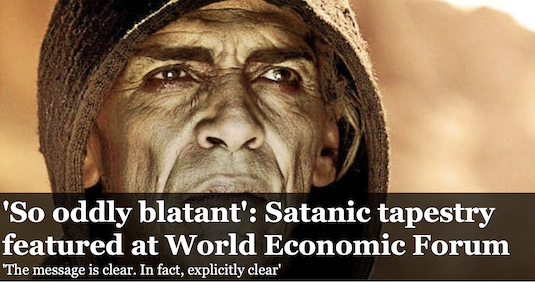Bob Unruh huffed in a Feb. 5 WorldNetDaily article:
The world’s richest people, whose who travel by private jet burning up fossil fuels from resort home to resort home all the while complaining that the “‘people” don’t want to buy expensive and unreliable electric vehicles to “save” the planet, do things differently.
Take, for example, what was represented to be “art” at a recent World Economic Forum gathering in Switzerland.
A “satanic” tapestry.
A report in the EU Times explained a “curious and disturbing” piece had gone viral after the Davos summit.
“It began when journalist Larry Alex Taunton went undercover to the annual globalist confab and infiltrated a conference room full of elites talking about the U.N.’s Sustainable Development Goals,” the report said.
[…]The report explained that tapestry “is a large mural created in 2009 by cross-dressing contemporary artist Grayson Perry.”
It shows, in the style of cave paintings, a birth, a man’s life, death, corporate promotions for various conglomerates and more.
“The tapestry begins with the birth of a baby along a river of blood that eventually flows into the waiting mouth of the Devil, ending in the death of an old man,” the report said.
Unurh is not going to mention that his source, the European Union Times, is linked to the wife of a racist skinhead, so it’s hardly trustworthy. And because neither Unruh nor his source apparently understand how art works, he’s content to smear the work as “satanic” for clickbait purposes. As someone who actually cares about art reported of the work:
The work, which measures fifteen metres by three metres, was inspired by Perry’s enthusiasm for the elaborate imagery of early 20th-century Sumatran batik fabrics.
The Walthamstow Tapestry, as he has named it, can be read from left to right. It starts with a graphically bloody scene of childbirth and then continues with depictions of the seven ages of man, through childhood, adulthood and eventually to death.
But the devil is in the detail. Around these large human figures teem hundreds of smaller images and words. The words are brand names, detached from their products but leaving behind them, Perry says, the aroma of the particular values they convey.
Because Unruh is a stenographer and not a reporter, he chose to lazily quote anonymous people on social media who, like him, can’t be bothered to do the most basic research and figure out what it’s actually about.
